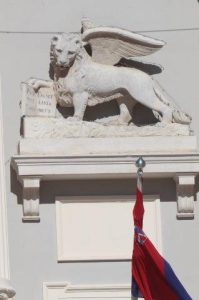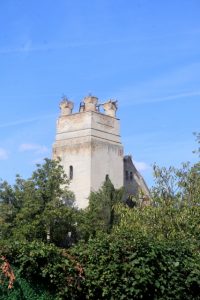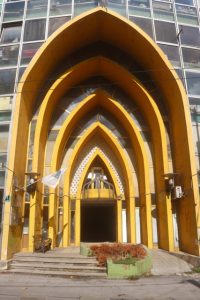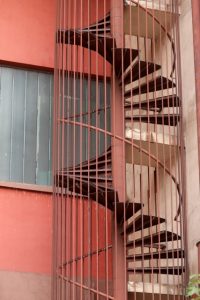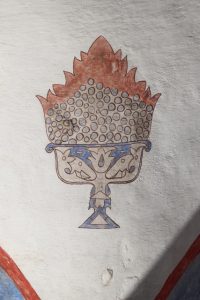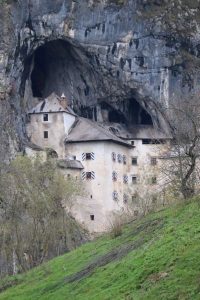Years ago we lived in Albania, freshly transformed form a communist state into an ultra-capitalist state. Surrounded by then-Yugoslavia, in the process of breaking up in individual countries through horrendous wars. To the extent that exploring the wider region, by jumping in the car and crossing the border, into Servia, for instance, was not an option. We did manage to visit, briefly, Croatia, and even more briefly, what is now North Macedonia, but no more. But things have changed, and now we can drive all over the place, cross multiple borders, and examine what has become from the Former Yugoslavia. A road trip into history, and enduring conflict.
01.the Former Yugoslavia plan
I could have called it the Western Balkans plan, of course, and technically, that would have been more appropriate, as we will only fleetingly visit Serbia, and we will skip North Macedonia – what used to be called the Former Yugoslav Republic of Macedonia – all together. But all of the countries we plan to visit – almost all – were once part of Yugoslavia, never mind that they fought savage wars amongst each other to untangle themselves from that agglomeration of states.
02. the way up (or down, whichever way you look)
Getting to the Balkans from where we are, in The Netherlands, takes a while, so we stopped for the night in a small town in Germany, Klingenberg. With a castle ruin overlooking the Main river, in between vineyards that produce the rather undrinkable red local plonk. Appropriately, our hotel was called Villa Croatia, with attached Adria restaurant. Where we had our first Balkan grill of the trip, accompanied by wine from Bosnia & Hercegovina.
03. Piran
One of the things I love about travelling is that I get to learn so much about the local history. For starters, I always thought that Croatian Istria bordered Italy, but that is not the case: there is a 50 km stretch of Slovenian coast that separates Croatia from Italy. And Piran in one of the three Slovenian harbours.
04. Ljubljana
We have been to Ljubljana once before, but that was close to 30 years ago, and only briefly, maybe less than a day, transiting to Croatia. Coming from Tirana in Albania at the time, we thought Ljubljana was wonderful, but we probably would have thought that of any city, coming from Tirana at the time.
Yet, once again we think Ljubljana is wonderful. Read on
05. Kostanjevica na Krki
It keeps pouring down, and all the various weather forecasts we consult are unanimous in that it will be pouring down for a while. The plan was to go to Maribor, where there is nothing special, but just a pleasant town with a lot of atmosphere. But not in the rain, so we skip Maribor, and focus on a couple of museum castles in the east of Slovenia. Museums are indoors.
06. the Bozidar Jakac Art Museum
The Bozidar Jakac Art Museum is housed in a former monastery, established in the 13th C, extensively rebuilt to its present form in the 18th C, but then dissolved in 1786, church furnishings auctioned off and church desacralized. The building was variously used afterwards, but fell in disrepair, until restoration began again in 1957. Now a national monument, it is surrounded by a huge sculpture garden, which we explored first, as the rain had temporarily reduced to a drizzle. The grass of the garden was equally wet, though, and my shoes not waterproof.
07. the mine
It is still raining. The idea to spend a day walking – I wouldn’t want to equate our strolls through nature to hiking – in the Žumberak Samoborsko Gorje, a national park just across the border in Croatia, was suddenly a lot less attractive than it seemed when planning our trip.
However, in the region there is one attraction ‘indoors’, and that is the Santa Barbara mine.
08. Zagreb
Still fleeing the rain, we move ever further east, to Zagreb. Another of those places we have been to some 30 years ago – but we don’t remember much, except that it, then, looked a very pretty city. No more, the first impression is of a run-down place, poorly maintained buildings, lots of destructive graffiti. A huge contrast with Ljubljana.
09. into Serbia
With Zagreb having been disappointing, with no more museums of vital interest left, and with a seemingly never-ending rain, we drive ever further east. To where, according to the weather forecast, the sun is shining. Well, not today, just yet.
10. Subotica
Soleil soleil!! We woke up to a bright sunny day, blue sky. Our strategy, going ever further east, has paid off.
But the first surprise in Subotica we got the night we arrived, and checked in in the Artist Hotel. A really nice place, with modern art everywhere – walls covered in large paintings, and each and every corner adorned with a sculpture or two, three. No need for a museum visit, here.
11. Sombor and Bac
We are heading south. There are hardly any motorways in Serbia, so we are back on the country roads, this time with better weather. As I suspected earlier, even in the sun the landscape is not very exciting, lots of flat, agricultural land. Around Subotica there are also a couple of wineries, but no trace of grapes, at least not where we are driving. It is a little too early to check out this enigma through a tasting.
12. Novi Sad
Novi Sad is one of those towns that you spent the day in, and you than realise that there is actually nothing really memorable. And yet, you have had a very entertaining day – or at least, we had.
13. Fruska Gora
So far, the Serbian country side has not been very enchanting. But south of Novi Sad is Fruska Gore, a hilly national park with a few peaks, of over 500 m even, and an attractive forest. And not only that! Fruska Gore is also home to no less than 16 monasteries, a bit like the Mount Athos of Serbia. Add several wineries to the equation, and we cannot go wrong, exploring this region.
14. the wine tasting
Part of the attraction of the Fruska Gore region is, or so claims the tourist information centre, the local wine. Which is why they have established no less than six wine routes. We like wine a lot, but we are not going to do six wine routes. Instead, my travel companion had selected a few wineries to visit, based on the rather generic descriptions of all of them.
15. Belgrade
Open a guide book, or a tourist website, and nobody is extremely enthusiastic about Belgrade. It is not a pretty city, there is little cohesion between its building styles, its city plan is a bit chaotic. But everybody agrees it does have a special vibe, and clearly shows joie de vivre. It is a bit like Subitica, and Novi Sad, everybody on the street, on the terraces, in the restaurants – but then even more so. Don’t these people have anything else to do?
16. Brutalist Belgrade
There is this part of Belgrade that doesn’t get to the tourists guides, or promotional websites. Because it is considered not very pretty. I beg to differ. I love the Brutalist architecture that originated after WW II, in socialist countries that needed to build houses quickly, without too much consideration for people’s choices and preferences.
17. the castle and the monastery
We have left Belgrade behind, but we will be seeing the Dunav – the Danube – one more time on this trip, at the Golubac Fortress. This is a fabulous castle, located at the place where the Dunav changes from what looks like a wide lake into a rather narrow gorge, ultimately ending at what is called the Iron Gates, an incredible change. And a strategic location for it, of course, hence, the castle.
18. the monuments
On the way to Mokra Gora, where we hope to ride the Sargan Eight railway, we pass two of Serbia’s most important monuments. One is the Šumarice Memorial Park, near Kragujevac. The park is home to a sombre museum that tells the harrowing story of the 1941 massacre of around 3000 civilians – men and boys – during the German occupation of Serbia.
19. the Sargan Eight railway
We had come to Mokra Gore, all the way in the west of Serbia, to ride the Sargant Eight railway, the narrow gauge railway that connected Belgrade with Sarajevo for 50 years, from 1925 to 1974. It no longer does, of course, and the refurbished section which is now the main tourist attraction of the area is only some 15 kms, connecting Mokra Gora with the station of Sargan Vitari.
20. the Serbian monasteries
Before exploring some of the fabulous Serbian Orthodox monasteries we had intended to visit the Maglič Fortress, one of Serbia’s best-preserved medieval fortifications. Built in the 13th century to protect the nearby Studenica and Žiča monasteries, its 2m-thick defensive walls with seven towers and a 20m-high keep stand on a ridge high above the Ibar river, 20 km south of Kraljevo. Access is via a footbridge, and a short, but steep hike up the hill. But we cannot find the footbridge, until someone tells us that the bridge was washed away a year ago, and that there is now a ferry instead.
21. the Serbian countryside
We spent some one-and-a-half weeks in Serbia, somewhat longer than we had anticipated beforehand. You like a place, you stay a little longer. And Serbia did not disappoint, in general. Belgrade and Subotica were highlights, as were the several Orthodox monasteries and their frescos – the multitude of frescos inside -, even though one may not take photographs.
But Serbia is also a big country. Read on
22. the road to Pristina
I wasn’t prepared for this. Sure, driving in the Balkans is a bit of a challenge, but in Serbia people more or less respected the traffic rules, although the further south we went, the more aggressive some drivers took to the road. Or – another observation -, after lunch the traffic discipline faded somewhat, possibly as a result of the occasional liquid, alcoholic accompaniment with the lunch.
But driving in Kosovo is different. Arriving in Prishtina on a Friday afternoon, traffic is complete chaos. Read on
23. Pristina
Pristina is by no means a beautiful city; like all the towns we passed on our way in Kosovo, construction is here also a dominant feature, and it looks like not much has been finished yet. Nevertheless, there is an old town, sort of, where some of the historical buildings from Ottoman times have been preserved. The best examples are part of the Emin Gjiku Ethnographic Museum, and have exhibits inside ranging from utensils and costumes to weapons. For us, the actual buildings are the most interesting.
24. the Gazimestan monument
Oh, and just north of Pristina is the Gazimestan monument, a somewhat inconspicuous tower, visible from the main motorway, yet, difficult to get to. It is not sign posted, despite its paramount importance. For Serbia, not for Kosovo, because this is where, in 1389, the Serbian forces, led by Prince Lazar, clashed with the Ottoman army under Sultan Murad I.
25. the Kosovo monasteries
The Kosovo monasteries are only the Kosovo monasteries, because they are nowadays located in Kosovo. But make no mistake, for all intents and purposes they are just as Serbian as the earlier ones I have shared with you. In fact, they are so Serbian, that they have to be protected by KFOR, the UN peacekeeping force in Kosovo, and by Kosovar police.
26. Peje
Already on the way to the Visoki Decani Monastery we notice all along the road small cemeteries adorned with the double-eagle Kosovo flag. These are the graves of the martyrs, or, as they are also being called, the heroes of the liberation: those who have fallen during the Kosovo war of 1997-1999, when Kosovo wrenched its independence from Serbia. To be clear, the relationship between ethnic Albanians and Serbs in what used to be the autonomous province of Kosovo has been strained for as long as generations can remember, and that is a long time in the Balkans, with atrocities committed on both sides.
27. Prizren
Although Prizren was also damaged during the Kosovo War, it somehow escaped the worst of destruction, and is nowadays called the museum town, on account of its Ottoman heritage houses. Museum town is pushing it, but it is a pleasant city, with charming old centre along the Lumbardhi River – a different Lumbardhi River than the one that comes down the Rugova Valley, but that is what you get if you call your rivers White River indiscriminately.
28. return to Tirana
We cannot go to the Western Balkans, and not go to Tirana. Evidently, judging from friends’ comments, and from more general info, Albania is the holiday country to be, at this moment in time. Lovely people, fabulous nature, great beaches, cheap food and cheap alcohol. Even though the country is not part of ex-Yugoslavia, the focus of this blog, we have to see this with our own eyes. Oh, yes, and we also lived here for two years, almost 30 years ago.
29. to Montenegro
We leave Tirana in the pouring rain, on our way to Montenegro. Somehow, we miss the connection to the motorway, and for an hour, or so, we drive the old road to Shkoder, in the north of Albania. And suddenly the Albania of the past is back again. Here no new developments, no fancy buildings, just the old houses like they were thirty years ago, with the metal doors closing off the small yard inside, and for the rest countryside. And poverty. The weather doesn’t help, of course.
30. the Montenegrin coast
I didn’t know that the coast of Montenegro is a popular tourist destination, of the sun and sea variety – there is very little sand along the Adriatic coast. Ulcinj is the first of a series of coastal towns that cater for the summer vacation.
31. Kotor
There is a pretty direct route from Budva to Kotor, but we chose the one over the mountains, which provides for fabulous views of the Lovcen National Park. Some distance inside the park is the Njegoš Mausoleum, built in the 1970s at the top of the park’s second-highest peak, Jezerski Vrh (1657m). The crypt, reached by no less than 461 steps, partly through a tunnel, houses a black granite statue, and presumably the remains, of Montenegro’s greatest hero, Petar II Petrović Njegoš.
32. Herceg Novi
The westernmost Montenegrin coastal town, all the way on the other side of the Bay of Kotor and just a few kilometres from the Croatian border, is Herceg Novi. And it is actually the nicest one. There is some development at the edges of town, with new apartments stacked against the mountain slope, and a big new hotel, but most of the centre of town, and middle part of the promenade that runs all along the coast, is low-rise, and for a large part still villas from the Yugoslav era, it seems.
33. the Ostrog Monastery
On our way to Podgorica we first stopped off at an old Roman bridge near the town of Kocani. The Most na Moštanici, constructed in the 3rd Century AD and believed to be the oldest existing bridge in Montenegro, has five graceful arches that crossed the once imposing Mostanica river, not much more than a dribble today.
The Ostrog Monastery is Montenegro’s most venerated Serbian Orthodox location, and a popular pilgrimage place. Read on
34. Podgorica
The various guidebooks and websites identify exactly one landmark in Podgorica, the Millenium Bridge, a 176 m long cable supported bridge over the Moraca River. And indeed, in the late afternoon sunlight this is a nice, if humble sight. But those guidebooks and websites have obviously no eye for the real gems of the city, a couple of truly Brutalist buildings from the Yugoslav-era concrete construction boom, led by home-grown Montenegrin architect Svetlana Kana Radevic. Of whom there is a more-than-life-size mural in the downtown neighbourhood.
35. the road to Sarajevo
We take two days to drive the 350 km from Podgorica to Sarajevo, again not along the shortest route, but definitely a more scenic one. Taking in some historically relevant sights, as well. (Two days, scenery and sights, so brace yourself for a lot of photographs again….)
36. Sarajevo
Sarajevo is one of those cities that, in my mind, will always be associated with war, in this case the Bosnian war from 1992 to 1995. Yet, in Sarajevo the traces of war are limited to bullet holes in buildings, and perhaps a few buildings that have been destroyed and not rebuilt. The most obvious signs of war are the multiple museums that in one way or another remember the war, show the horrifying details, and charge for that.
37. Zenica
We didn’t plan to go to Zenica at all. After all, what on earth is there to see? But through our newly developed interest in brutalism, or socialist modernism, suddenly a couple of ideas had popped up, mostly centered around hotels. Some specialist website mentioned the Hotel Internacional, and the Hotel Dubrovnik, both in Zenica. And anyhow, it was more or less on the way.
But driving into town every thought of hotels is quickly overshadowed by a huge apartment building, the Lamela building, a residential tower 25 floors and 101 meters high. Read on
38. Travnik
In sharp contrast to Zenica, Travnik is a rather low-key, low-rise town, a little left behind. During the Ottoman occupation of Bosnia it figured for a while, 18th and 19th C, as the local capital of the Ottoman Bosnia province, which not only prompted many locals to convert to Islam, but also sparked the construction of quite a few mosques. The most outstanding example of this is perhaps the most beautiful mosque in the country, the Suleimanyi Mosque, popularly known as the multi-coloured mosque.
39. Mostar
Perhaps Mostar is not one, but two cities. We are staying in the old town, the Muslim quarters, cobbled streets, souvenir shops, plenty of restaurants, terraces that sell Bosnian coffee, baklava. Even more than the old town in Sarajevo, it is the feeling of being in Turkey. There are also several mosques, and the remains – the women’s quarters, the men’s have been destroyed in the war – of an authentic Ottoman house, called Kajtaz House. All very nice, and all very touristic, again, even more so than Sarajevo.
40. Intermezzo
Time to look back a little, before I forget. We have now been through seven countries, Slovenia and Croatia very briefly, the others somewhat longer – but by far not long enough to have sufficient experience to make sweeping statements about differences.
Yet, a few things do stand out, from our limited interactions with people. Read on
41. Split
We have reached Croatia again, after a comfortable ride along a comfortable motorway, something we haven’t had for a while.
Our first stop is Split, the largest city on the Dalmatian coast, originally settled by the Greeks in the 3rd or 2nd C BC. The most important building, however, is of Roman origin, the Palace of the emperor Diocletian, built at the beginning of the 4th C AD.
42. Trogir
Trogir, just half an hour drive from Split, is another town that was part of the Venetian Republic – after the Greeks and the Romans, the early Croat Kingdom and Byzantium, amongst some of the past rulers. It is situated on a small island that easily could be, and has been, fortified. The town has been listed as a UNESCO World Heritage Site, because of the architecture dating from its Venetian period, and indeed it is full of palaces, that are being reached through narrow streets.
43. Sibenik
Sibenik, too, was long a Venetian town, but unlike the others we have seen so far, it was only established in the 11th C, by Slavs. Yet, the main characteristics of the town are, again, its narrow streets and alleys, many in the form of stairs. Walking through the old town is entertaining, finding various sculptures innocuously positioned on walls of past palaces, or just some inscriptions.
44. Plitvice National Park
After the several ancient Venetian towns of the last few days, with narrow streets and impressive churches, we have temporarily seen enough of those, for a while. So we decide to move inland and aim for the Plitvice National Park, marketed as ‘Croatia’s top natural attraction and the absolute highlight of the Adriatic hinterland’. It is. A series of sixteen lakes drop down a total of 133 meters, from one into the next, through waterfalls and cascades, over a distance of eight kilometres. In itself already a fabulous natural phenomenon, but in mid-October further enhanced by the autumn colours of the forests at the various lake sides.
45. the last of Croatia
We have lots of plans for the rest of Croatia, on our way home. But we are running out of time, because in the end we spent quite a few more days than planned in several of the towns we have been to, not in the least because of our newly-discovered fascination with brutalist architecture. We also have some unfinished business left in the NW of Slovenia, where we fled from the rain at the start of our trip. So we decide to skip the Istria peninsula, with its picturesque towns, more churches and Roman remains. And head back to Slovenia, instead.
46. the Postojna Cave
One of the things we have not yet done during our Balkans trip is visiting a cave. It is not that there are no caves: the Western Balkans is dominated by a karst landscape that contains many caves, derived from dissolving carbonate rock through underground rivers, or just water seeping through. In fact, the name karst has been derived from here: the Kars Plateau is the NW part of the Dinaric Alps.
47. Another intermezzo
My last reflections were on the people of the countries we have passed through so far. But in the last week or two, we have moved from Albania, Montenegro, Bosnia and Hercegovina, into Croatia, and now Slovenia. And without even talking to anybody, the difference is striking.
48. Bled and surroundings
We end our trip where we were supposed to have started it, in Bled, in the NW of Slovenia. Where we fled for the rain from Kranjska Gora almost seven weeks ago. It isn’t so bad now, but it is once again raining. We skip the walks through two of the gorges near Bled, the very touristic Vintgar Gorge and the more remote 2km-long Pokljuka Gorge (or georges, as our landlady keeps on calling them). We skip the trip across the 1611m high Vršič Pass, not only because in the clouds the views are by far not as spectacular as described in the many guide books, but also because the road is closed, simple as it is.


